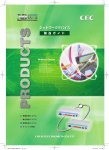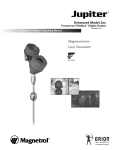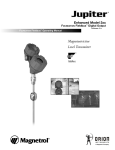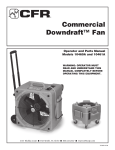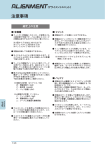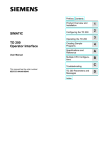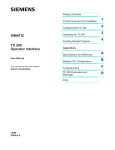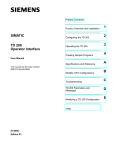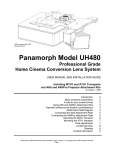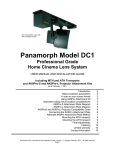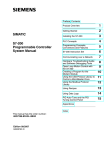Download measuring and adjusting the temperature with cpu 224 plc and td
Transcript
MEASURING AND ADJUSTING THE TEMPERATURE WITH CPU 224 PLC AND TD 200 OPERATOR INTERFACE SIEMENS Gabriel Nicolae Popa, Assoc. Prof. PhD. Eng., Faculty of Engineering Hunedoara, Politehnica University Timişoara Iosif Popa, Assoc. Prof. PhD. Eng., Faculty of Engineering Hunedoara, Politehnica University Timişoara Corina Maria Diniş, Lecturer PhD. Eng Faculty of Engineering Hunedoara, Politehnica University Timişoara Angela Iagăr, Lecturer PhD. Eng Faculty of Engineering Hunedoara, Politehnica University Timişoara ABSTRACT: In the paper are presented two applications that perform the function of thermostat for measuring and adjusting the temperature. Applications were made with CPU 224 PLC, extension modules EM 231 RTD and EM 235, and operator interface TD 200 (Siemens). Temperature measurement in both cases is made with a Pt 100 thermo-resistance (the resistance grows linearly with temperature). In both applications, it can view the operator interface TD 200: current temperature, maximum temperature and minimum temperature that exceeded the required value of temperature. For TD 200 operator interface configuration is presented. At both applications it using a digital output of the CPU 224 PLC to connect or disconnect the power of the furnace through a contactor (or electro-valve for gas). The article presents a comparative analysis between the two programmes versions. KEYWORDS: Adjust, measure, operator interface, PLC, temperature. 1. INTRODUCTION Process control must be carried out with the help of electronic devices that provide stability, accuracy and decreases the length of the transient processes [1,4,6,8]. As a result of the rapid development of technology, many of the problems have been solved through the use of PLCs, and possibly through the use of a PC for supervision. By using PLCs shrinks the number of connections between devices (displays, motors, sensors, switches, valves, etc.) and there is the possibility of using communication tools, thus ensuring a high level of service and high flexibility in controlling processes [7,9,14]. In automated systems, PLCs represent the main part of the management and control of the process. Through the execution of a program stored in the program memory, programmable machine monitors the status of the process by the signals received from the input devices. By building the program, PLC determines actions on output devices. In the case of more complex processes it is possible to connect several PLCs from a PC [5,15]. Automatic management of industrial processes to ensure both with general purpose PLCs type, and, also, with specialized PLCs type. Examples of specialized PLCs for industrial processes may be: automation equipment for boilers and heating installations in 275 buildings, control and signalling equipment for the detection and alarm, fire detection, driving pumping stations and water supply of communities, etc. The operative part orders send command to the system and to the operative information about evolution is collected under orders sent [2,3]. In the paper are presented two applications made with PLC for the temperature measurement and adjustment of industrial furnaces. The first application, uses CPU 224 PLC [11], extension module EM 231 RTD (specialized for thermo-resistance connection) [13], TD 200 operator interface [12] and thermoresistance Pt 100 [16]. The second application, use the extension module EM 235 (with four analogue inputs and one analogue output, 12 bit conversion); it is use only one input and one analogue output [13]. The analogue output is used to inject a constant current (regardless of the temperature) through Pt 100. Due to the change in temperature will change the voltage on Pt 100 that will be measured with the analogue input module. For the second application, the program is complicated because it converts the measured voltage on the temperature displayed into TD 200 operator interface. 2. PLCs. CPU 224 SIEMENS PLCs are simple microcomputers that are built specifically to deal with issues of combinational and sequential programs. They are used to replace the combinational and sequential automation made with contacts and relays. In a general form PLC can be considered as a piece of equipment that allows the logical linkages between a large number of inputs and outputs, without additional interfacing devices. [5,7,11]. These systems offer fewer characteristics than process PCs, but can be used by less qualified staff due to application-oriented languages. Carrying out a program on such a system is synchronous. PLCs are built specifically to operate in industrial environments, with the necessary protections against environmental pollution from industry and having interfaces adapted for transducers and actuators elements most commonly used in the industry. For more advanced applications, there is currently high performance PLCs which approaches the complexity of computers. The PLCs work with words of 8, 16 and 32 bit and may perform floating point arithmetic operations. PLC types available on the market are spread, and their characteristics are different from one manufacturer to another. The S7-200 PLCs (Siemens) is intended for lowcomplexity applications and includes several types of central units. For a schedule of this series are required, in addition to functionality, a PC computer, programming Step 7 MicroWIN 32 and a communication cable between the PC and PLC (PPI port serial port on computer - PC/PPI). Siemens manufactures and a new series of automatic small S7-22 x, equipped with communication facilities on the network embedded in the central unit [11]. Table 1 The main characteristics of CPU 224 [11] Battery backup Yes Communication port type RS 485 SIMATIC S7-200 For use with Series Input type Analogue, Digital Manufacturer series SIMATIC S7-200 Maximum baud rate 187.5 kbit/s 203 (168 Digital, 35 Maximum inputs/outputs Analogue) Maximum Operating +45°C Temperature Minimum operating 0°C temperature Mounting type Rack Number of communication 1 ports Number of I/O 24 Number of inputs 14 Number of outputs 10 Output current 750 mA Analogue, Digital, Output type Transistor Computer, SIMATIC Programming interface PG/PC Programming language used STL, LAD, FBD Scan time 0.22 μs 276 12 kB (Program Memory), 8 kB (Data Memory) Voltage supply 20.4 → 28.8 V D.C. Width 120.5mm Depth 62mm Length 80mm An S7-200 PLC consists of a CPU module, alone or with multiple extensions. CPU module is composed of a central unit, power supply and input/output in a compact structure. CPU module has a number of status LEDs (SF/DIAG, RUN, STOP) and visualization of the status of inputs and outputs. Step 7 MicroWIN 32 is a software package for programming and configuring PLCs Siemens S7-200 series. This software package allows set parameters for hardware debugging, editing, and uploading in PLCs programs developed. Languages supported by Step 7 MicroWIN 32 are: • STL, which is a text language consisting of usual instructions list; • LAD, which is a semi-graphic language, consisting of objects, which is achieved through interconnection circuits, called networks, which are similar to those made with contacts and relays; • FBD, is a semi-graphic language, consisting of objects, which is achieved through interconnection circuits called networks, which are similar to those made with integrated circuits. In principle, for any industrial application where is used PLC using the following sequence of command diagram [10]: a. Process must be selected to be controlled. The system automatically can be a machine or a process. Process control is constantly supervised by input devices (sensors) that transmit signals to the programmable machine. When running the machine scheme, PLC transmits signals to output devices (elements) that determine the operating mode of the process. In order to understand the functioning of the program it is necessary to construct flowcharts. b. It must set the devices that connect to the entry and exit of programmable machine. Input may be connected to different switches, sensors, etc. It can connect the output coils, valves, electromagnetic valves, micromotors, relays, signal optical instruments and/or acoustic, LEDs, etc. c. Implementation of the programme with specific PLC instructions according to the flowchart. The program must be stored in the PLC programmable memory. After the implementation of the programme, it is necessary to detect program errors. Also, through the program shall be provided for all possible situations that may arise in the process. Before setting off for the first time, the facility must be checked once all input and output if are connected to the correct inputs and outputs programmable machine. After connection of the power supply voltage, the process begins to be controlled by the PLC. Total memory available 3. OPERATOR INTERFACE WITH ALPHANUMERIC DISPLAY TD200 SIEMENS User label Keys TD200 (Text Display) is a operator interface with text display designed specifically for the family S7-200 PLCs. Communication is done through the serial port by using the PPI Protocol. The unit is powered either from the mains to 24V from PLC (via special cable TD/CPU) or from a separate voltage source (i.e. 230V, 50Hz)[12]. The most important functions of the TD 200 are: • Display of read messages from AP S7-200; • Adjusting the variables in the process; • Possibility to control the process from the buttons F1F8; • Ability to force/release values in input/output registers; • Possibility to set clock and date for S7-200 units that have built-in clock function; • Provides menus and messages in six languages. TD200 interface works as master when it is connected to one or more automated S7-200. TD200 is also designed to operate together with other devices in the network master. Fig. 1. Operator interface TD200 Siemens TD200 is a small, compact, providing all the necessary elements for the creation of the PLC S7-200 CPU. Interface components are described in table 2. Table 3 contains a description of the command keys and table 4 describe the functions of the keys F1-F8. Table 2 Operator interface components TD200 description Component Description Text display The display is illuminated and made area up of liquid crystal display (LCD) with a resolution of 33x181 pixels. It is used to view messages. Communication 9-pin D connector for port communication with S7-200 PLC with TD200 using the cable provided TD/CPU. Power It can connect an external voltage connection source. This connection is not required if is used the cable provided TD/CPU. TD/CPU cable A serial cable is straight-trough 9pins used for communication with PLC and power supply TD200 interface. 277 The label used to customize the keys. TD200 has nine keys. Five of them performing and four built-in functions can be used to perform user-defined functions. Fig. 2. Operator interface TD200 components Table 3 Description of the command keys the operator interface TD200 Command Description keys ENTER It is used to write data to the PLC and to confirm (acknowledge) a message. ESC Is used to switch (toggle) between the display of messages and menu mode or to interrupt an edit. Up arrow It is used to increment a value or to navigate upwards. Down It is used for a value or decrement to arrow navigate down. SHIFT Is used to modulate the functions of all keys. When this key is touch will be displayed blinking letter S in the lowerright corner. Table 4 Description of the keys for user-defined functions F1-F8 keys Description F1 F1 key bit sets the Mx 0. If is press SHIFT + F1 set Mx. 4. F2 F1 key bit sets the Mx 1. If is press SHIFT + F1 set Mx. 5. F3 F1 key bit sets the Mx 2. If is press SHIFT + F1 set Mx. 6. F4 F1 key bit sets the Mx 3. If is press SHIFT + F1 set Mx. 7. TD200 is a display device used for alpha-numeric display of messages validated by the PLC S7-200 CPU. TD200 interface programming is not necessary. The only operating parameters stored in the memory are the interface address TD200, S7-200 CPU address, baud rate and location configuration block (called TD200 Block). This block is stored in the memory variable (V) functionality. The interface configuration parameters as language, TD200 discount rate, message and the validation of the message bits are stored in the block TD200. On start-up, it reads the configuration block TD200 and verifies the accuracy of all parameters. If everything is alright, start checking TD200 validation of bits messages to determine what message is necessary to display. In the last dialog box will use the "Finish" button to validate and save the block parameters and close the configuration tool. To begin configuring it will press the button "Next". The program Step 7 Micro/WIN is equipped with a "special feature" (wizard) to ease the Bloc's TD200 configuration and messages in the data memory of the PLC S7-200. The selection options and creating messages, wizard automatically writes TD200 block with parameters and text messages in TD200 window Data blocks. This block of data (Data Block) and block containing TD200 can now be downloaded (downloaded) in memory of the machine. This section contains the procedure for creating a template. It will use the following guidelines to create a block TD200 and two messages. The first message will contain the text and data. The second message will require acknowledgement (acknowledge) operator. To select the Setup function of the interface it will select Tools TD200 > Wizard. To navigate forward or backward, use the buttons "Next" and "Previous". In the last dialog box will use the "Finish" button to validate and save the block parameters and close the configuration tool. 4. REALIZATION OF MEASURING AND ADJUSTING TEMPERATURE APPLICATIONS WITH PLC In this chapter are presented two applications that perform the function of thermostat for electric or gas industrial furnaces. Applications were made with PLC Siemens CPU 224, extension module EM 231 RTD (can connect two temperature sensors of various types configurable from switches) and EM 235 (4 analogue inputs and one analogue output, voltage or current, configurable from switches) [13], TD 200 operator interface [12]. Temperature measurement in both situations is made with Pt 100 thermo-resistance (100 ohm at 0°C) [16]. Fig.3. The laboratory equipment used in experiments 278 Fig.4. CPU 224 PLC and EM 235 and EM 231 RTD extension modules Fig.5. Pt 100 thermo-resistance used in experiments (connected on a power resistor) To check the operation of the programs have set the temperature lower limit value at 22 °C, and for the upper limit at 25 °C. While the Pt 100 temperature measured is between 22 and 25 °C, it displays the message 1. If the temperature is higher than the upper limit, in addition to the message 1 a message 2 is displayed. If the temperature is less than the lower limit, in addition to the message 1 a message is displayed 3. 4.1. Measuring and adjusting the temperature with Pt100 and EM 231 RTD module The operation of this application is the thermostat switch to the temperature thresholds, with the values imposed by the program. The temperature and the maximum and minimum values are displayed on the operator interface TD 200 (Siemens). A digital output is using the output Q0.0 that is 1 logical when the temperature is lower than the lower value, or 0 logic when the temperature exceeds the upper assessment threshold. Output Q0.0 (electric contact), connects with the coil of a contactor or electro-valve for command of a three-phase power resistors (which produces heat) or a servo-valve for the gas supply to a gas oven (fig. 6). This application requires the following equipment: - CPU 224 (Siemens); - EM 231 2xAI RTD (Siemens); - operator interface TD-200 (Siemens); - thermo-resistance Pt 100; - a power autotransformer, a contactor K that supply the power resistance R. The switches of EM 231 RTD were achieved the following configuration (at the 8 switches) for Pt 100: SW1 SW2 SW3 SW4 SW5 SW6 SW7 SW8 0 0 0 0 0 0 0 1 SW1-SW5 configures the type of thermo-resistance; SW6 - 0 to measure the positive temperatures, 1 to measure negative temperatures; SW7 - 0 degrees Celsius, 1 degree Fahrenheit; SW8 - 1 for thermo-resistances with 2 or 4 wire, 0 for thermo-resistance with three conductors. In this application, Pt 100 thermo-resistance connects to EM 231 RTD: - -a Pt100 connector at A- and a-; - +a Pt100 connector at A+ and a+. EM 231 RTD feeds from CPU 224 supply. CPU 224 connects to power supply single phase, 230V, 50 Hz, CPU 224 has a internal switched mode power supply 24V. Is connected, also, an analogue module 235 EM (four analogue inputs and one analogue output) with 12bit conversion. This module cannot be used at the first application. Program listing for application 1 Network 1 Setting the limits of the operating temperature of the regulator LD Prima_scanare // In the first cycle of operation // SM0.1=1 MOVD +0, VD260 // To delete the values in VW260 and //VW262 MOVW +0, VW200 // Deleting the memory where it will be // introduced AIW8 entry MOVW +250, VW260 // The upper limit setting of regulator // = 25°C; temp. value x 10 MOVW +220, VW262 // The lower limit setting of regulator // = 22°C; temp. value x 10 Network 2 Calculating and validating the message 1 LD Tot_timpul_1 // SM 0.0 is logical 1 and determine // program execution MOVW AIW8, VW200 // The size of the analogue displacement //measured (temperature) at the AIW8 in memory of VW200. MOVW VW200, VW116 // Transfer result at VW116 (which is in //connection with operator interf. TD 200) for displaying information. S V12.7, 1 // Message 1 validation to display // TD 200. Network 3 If the temperature exceeds the maximum value, it validates the message and exit Q 0.0 are reset. LDW>= VW200, VW260 //If the temperature is > = than the //stored maximum temperature, VW260 = V 12.6 //it validates the message 2 and will be //displayed on the TD //200. R Q0.0, 1 // Q0.0=0 output (reset) MOVW VW260, VW136 // Transfer the result to memory //VW136 (who is in touch with TD 200 //operator panel) to display message 2. Fig.6. Connection scheme of CPU 224 PLC, TD 200, EM 231 RTD and power resistance R Because the application uses the first entry of the module EM 231 RTD, and before this module is connected the module EM 235 (with four analogue inputs), AIW8 input is used for temperature measurement. TD-200 operator interface displays the current value of the temperature measured (1 message), overcoming the higher set value (message 2) and minimum value set (3 message). The program was developed in STL, but can be viewed, also, on LAD or FBD. AIW8 is the number 1 input of EM231 analogue module, and EM 235 module is connected before EM 231 RTD (which has inputs AIW0, AIW2, AIW4, AIW6). Fig.7. Connect the conductors to the first application (with EM 231 RTD module) 279 Network 4 If the temperature falls below the minimum value, it validates the message 3 and exit Q 0.0 sets. LDW<= VW200, VW262 //If the temperature is the //minimum temperature than < = stored in VW262, =V12.5 //validating message 3 and will be displayed on the TD 200. S Q0.0, 1 // Q0.0=1 output (set) MOVW VW262, VW156 // Transfer the result to memory //VW156 (who is in touch with TD 200 operator panel) to display the //message 3. Network 5 End of programme MEND // End of programme. Data Block for TD 200 configuration // data block DB1 (V memory): // // The parameters block for TD200 for writing messages measured //temperature values and to overcome the upper and lower limits. // Configuration is done with specialized for TD 200Wizard //in the STEP 7 Microwin VB0 'TD' // Operator panel identification TD 200 VB2 16#10 // English setting and up-dating fast VB3 16#00 // Setting 20 characters; Button up V3.2; // Button down V3.3 VB4 3 // Setting the number of messages: 3 VB5 0 // Setting the buttons and their association with //memoirs M 0.0-M 0.7 VW6 100 // Setting memory addresses starting with VW100 VW8 12 // Setting addresses for validation bits VW12 messages // Message 1 // Validation bit message 1 V12.7 VB100 'Temperatura = ' VB114 16#00 // No editing, no confirmation and no password; VB115 16#31 // Word without a sign; a digit to the right of the //decimal place; VW116 16#0000 // Moving the date to be displayed. VB118 'ßC' // Message 1 ends. // Message 2 // Validation bit message 2 V12.6 VB120 'Temperatura > ' VB134 16#00 // No editing, no confirmation and no password; VB135 16#31 // Word without a sign; a digit to the right of the //decimal place; VW136 16#0000 // Moving the date to be displayed. VB138 'ßC' // Message 2 ends. // Message 3 // Validation bit message 3 V12.5 VB140 'Temperatura < ' VB154 16#00 // No editing, no confirmation and no password; VB155 16#31 // Word without a sign; a digit to the right of the //decimal place; VW156 16#0000 // Moving the date to be displayed. VB158 'ßC' // Message 3 ends. //end configuration block TD 200. Fig.8. Displaying the first message (current temperature) on the operator interface TD 200 Fig.9. Displaying the first message (current temperature) and the second (upper limit value being exceeded) operator interface TD 200 4.2. Measuring and adjusting the temperature with Pt100 and EM 235 module (4 analogue inputs and 1 analogue output) with 12-bit conversion The operation of this application is the thermostat switch to the temperature thresholds, with the values imposed by the program. The temperature and the maximum and minimum value of the temperature are displayed on the operator interface TD 200 (Siemens). A digital output is using Q0.0 that is 1 logical when the temperature is lower than the lower value, or 0 logic when the temperature is higher than the upper threshold (fig. 11). This application requires the following equipment: - CPU 224 (Siemens); - EM 235 (4xAI, 1xAQ, Siemens); - operator interface TD-200 (Siemens); - thermo-resistance Pt 100; - a power autotransformer, a contactor K that supply the power resistance R. On the panoply of experimentations are three connected modules: a PLC CPU224, an analogue extension module EM 235 and another extension module EM 231 2xRTD; last module in this application shall not be used. CPU 224 is fed from single-phase mains voltage (230 V, 50 Hz). The PLC has an internal voltage source with a value of 24 V DC. From this source is feeding EM 235 module. Output Q0.0 (contact form), connects with the coil of a contactor or electrovalve for command of a three-phase power resistors (which produces heat) or a servo-valve for the gas supply to a gas-fired furnace. EM 235 is powered from + 24 V and the mass of the internal source of CPU 224. In this application, it can use the analogue output in the form of the current (maximum 20 mA, between M0 and I0 terminals) from which connects Pt 100 thermoresistance (100 ohm at 0 °C). Pt 100 is injected into a constant current of 12.5 mA. With a 12.5 mA current injected into the Pt 100 is obtained 5 mV/°C. If the Pt 100 change with temperature (increases with increasing temperature), the voltage on the Pt 100 also increases. By measuring the voltage on Pt 100, using AIW0 input of EM 235 module, it can measure temperature with Pt 100. Modification of Pt 100 resistance is about 0.4 Ohms/°C. Fig.11. Connection scheme of CPU 224 PLC, TD 200, EM 235 and power resistance R Fig.10. Displaying the first message (current temperature) and the third (lower limit value being exceeded) operator interface TD 200 280 Measurement range of Pt100 is usually between -60 and 400 °C. Resistant Pt 100 connects between M0 and I0 (exit 235 EM module). The ends of thermo-resistance connect to the first input (AIW0) EM 235 analogue module. His Pt 100 connecting at the entrance of EM 235 is between A- (ground) and A +. AIW0 input is the number 1 input from EM235 module which is used in the application. Module EM 235 entries set the microswitches to measure single-polar voltages (10 V). At switches EM 235 has achieved the following configuration (at the 6 switches): SW1 SW2 SW3 SW4 SW5 SW6 0 1 0 0 0 1 TD-200 operator interface displays the current value of the temperature measured (1 message), exceeding the higher set value (message 2) and exceeding the minimum value set (3 message). The program was developed in STL, but can be viewed and the LAD or FBD (Siemens) =V12.5 //validating message 3 and will be displayed on the TD 200. S Q0.0, 1 // Q0.0=1 output (set) MOVW VW262, VW156 // Transfer the result to memory //VW156 (who is in touch with TD 200 operator panel) to display the //message 3. Network 5 End of programme MEND // End of programme. The data blocks to set up TD 200 is the same way as the application 2. Program listing for application 2 Network 1 Setting the limits of the operating temperature of the regulator LD Prima_scanare // In the first cycle of operation // SM0.1=1 MOVD +0, VD260 // To delete the values in VW260 and //VW262 MOVW +0, VW200 // Deleting the memory where it will be // introduced AIW8 entry MOVW +250, VW260 // The upper limit setting of regulator // = 25°C; temp. value x 10 MOVW +220, VW262 // The lower limit setting of regulator // = 22°C; temp. value x 10 Fig.12. Connect wires for the second application Network 2 Calculating and validating the message 1 LD Tot_timpul_1 // The bit SM0.0 is 1 logic and determine //program execution MOVW AIW0, VW200 // Moving the value of the input AIW0 // in the VW200. -I VW252, VW200 // Substracting value for 0° C (offset) // VW200-VW252. DIV VW250, VD198 // The result of VD198 is divided in // VW250 (for 1 ° C) MUL +10, VD196 // The remainder is multiplied by 10. DIV VW250, VD196 // Dividing the remaining value from // VD196 to VW250 (1 ° C) MOVW VW198, VW160 // The movement amount with a decimal // place to the left MOVW +0, VW198 // Deleting content from VW198. MUL +10, VD198 // Multiplying the temperature measured // with 10 +I VW160, VW200 // Result decimal place value roundup MOVW VW200, VW116 // Transfer result in VW116 (which is in //connection with operator panel TD 200) S V12.7, 1 // Message 1 validation // for TD 200 display. Network 3 If the temperature exceeds the maximum value, it validates the message and exit Q 0.0 are reset. LDW>= VW200, VW260 //If the temperature is > = than the //stored maximum temperature, VW260 = V 12.6 //it validates the message 2 and will be //displayed on the TD //200. R Q0.0, 1 // Q0.0=0 output (reset) MOVW VW260, VW136 // Transfer the result to memory //VW136 (who is in touch with TD 200 //operator panel) to display message 2. Network 4 If the temperature falls below the minimum value, it validates the message 3 and exit Q 0.0 sets. LDW<= VW200, VW262 //If the temperature is the //minimum temperature than < = stored in VW262 281 Fig.13. Looking at the experience of the second application In the second application, the experiments connected the mili-ammeter to be able to measure the constant, regardless of the temperature, by Pt 100 thermoresistance. Constant current is generated by extension module EM 235 (12.5 mA) (fig. 13). 4.3. Issues regarding the use of PLCs The most significant disadvantages of classical control systems (with relays and switches) are: - high working time for connections between electrical devices; -the difficulty of replacement parts; -difficulty in determining of faults; -the need for the use of a qualified staff with practical experience; -the emergence cannot be determined the time of elimination of the defect; usually this time is high, the process must be stopped. With the invention of PLCs, changed the way in which the command installations; its occur a number of advantages. The advantages of using PLC in command installations are: - compared to classical control systems (with relays) number of conductors needed to greatly reduce the connections (generally 80%); - power consumption is much lower due to the fact that a PLC uses less electricity than a group of relays that performs an equivalent function; - fast determination and remedy the issues in the system; - rapid adaptation to different applications with command systems with PLC by modifying the program running in the PLC (no change of conductors for connections, being only necessary to adapt certain devices for input and output); - the total size is reduced compared to conventional equivalent facilities; - command installations with PLCs are cheaper compared to the classics, especially in the case of installations with a large number of input devices and output; - safety in operation is greater in the case of orders made with PLCs. 5. CONCLUSIONS PLCs are used increasingly more often in the industry. An application of those is temperature control of industrial furnaces (e.g. for drying of painted components) with electrically or gas heated. PLC CPU 224 Siemens belongs to the category of low-capacity general PLC. For use in measuring and monitoring the temperature industrial furnaces have utilized a specialized expansion module (EM 231 RTD) or general (EM 235 4AI, 1AQ) together with PLC. Use specialized extension module provides an easier programming of PLC, but it can be used for a limited range of applications. The applications are based on operation of thermostat with switch to two limits for temperature (limits can be changed in the program). The current temperature and the maximum value or the minimum values are displayed on the TD 200. The values shown are displayed with one decimal place. 282 The programs were implemented in STL, but due to the programming environment (Step7 Microwin) can be displayed in LAD and FBD. 6. REFERENCES [1]. Andrei D., Georgescu I., Guran M. – Automatizări în industria minieră, Editura Tehnică, Bucureşti 1977. [2]. Badea I. şi colectiv – Protectia prin relee şi automatizarea sistemelor electrice, Editura Tehnică, Bucureşti, 1973. [3]. Groza V.R. – Analiza şi sinteza dispozitivelor numerice, Universitatea “Politehnica” Timişoara, 1995. [4]. Poanta Aron, Pătrăşcoiu Nicolae – Circuite şi echipamente electronice utilizate în industria minieră, Editura Didactică şi Pedagogică, Bucureşti, 1997. [5]. Pop E., Leba M.C. – Microcontrolere şi automate programabile, Editura Didactică şi Pedagogică R.A., Bucureşti, 2003. [6]. Popa G.N., Popa I. – Instalaţii electrice, Editura Mirton, Timişoara, 2005. [7]. Popa G.N., Popa I., Deaconu S. – Automate programabile în aplicaţii, Editura Mirton, Timişoara, 2006. [8]. Popa I., Popa G.N. – Dispozitive electronice cu structură cablată şi programată de protecţie a motoarelor asincrone trifazate de joasă tensiune, Editura Mirton, Timişoara 2000. [9]. Toma L. – Sisteme de achiziţie şi prelucrare numerică a semnalelor, Editura de Vest, Timişoara, 1997. [10]. Voloşencu C. – Standardizare şi metodologii de proiectare în automatizări industriale, Editura Matrix Rom, Bucureşti, 1998. [11]. *** – Siemens S7-200 Programable Logic Controller. User Manual, Siemens, 2003. [12]. *** – Siemens TD 200 Operator Interface. User Manual, Siemens, 2005. [13]. http://www.automation.siemens.com/ [14]. http://www.control.com/ [15]. http://www.directindustry.com/ [16]. .http://www.ziehl.de/ziehl/englisch/temperatu re_monitoring/5pt100sensoren_e.pdf








